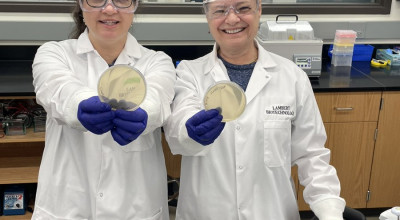Tech Connects: Comas Haynes
This Tech Connects podcast features Comas Haynes, Principal Research Engineer in ATAS and Materials/Energy Branch Head in the Intelligent Sustainable Technologies Division. There are a few key factors that are driving further automation of poultry processing operations. These include labor shortages and the need for more precision while processing poultry to reduce wasted product. This project focuses on the typical American processor chilling phase, wherein the poultry product is dropped from individual shackles into immersive screw auger arrangements.
There are a few key factors that are driving further automation of poultry processing operations. These include labor shortages and the need for more precision while processing poultry to reduce wasted product. This project focuses on the typical American processor chilling phase, wherein the poultry product is dropped from individual shackles into immersive screw auger arrangements. Currently, single-piece processing control is lost as poultry product becomes mixed, and traceability/repeatability features likewise vanish. The intervention is to instead keep poultry product on the individual shackles (i.e., “in-line”) during immersive chilling, while also improving the chilling effect by superimposing counter-rotational spin patterns onto the translational “line speed”. This additional vector of rotational motion increases convective chilling via increased relative velocity between poultry product and chiller fluid. This also introduces periodic disturbances of thermal boundary layers via the clockwise-counterclockwise directional changes. Tests have confirmed the enhanced chilling caused by the rotating shackles concept, and this success alleviates the concern that in-line chilling would be inferior to the screw auger approach. It is interesting to note also that the same approaches to thermal science and thermal management that are being used to advance some of the clean energy initiatives of tomorrow (such as hydrogen technologies), are being applied in novel ways by this project team to enhance the food production of today.
Enhancing the State of Georgia's economic development is one of the four focal points listed in the GTRI mission statement. The enhanced chilling project is sponsored by the State of Georgia through the Agricultural Technology Research Program (ATRP), along with the United States Department of Agriculture (USDA) as a recent co-sponsor. ATRP intends to drive transformational innovation in the state’s (and ultimately the nation’s) poultry, agribusiness, and food manufacturing spaces. Since Georgia is the #1 state in the nation in the poultry processing sector, this project is a significant part of GTRI’s alignment with its mission statement.
There are a few key factors that are driving further automation of poultry processing operations. These include labor shortages and the need for more precision while processing poultry to reduce wasted product. This project focuses on the typical American processor chilling phase, wherein the poultry product is dropped from individual shackles into immersive screw auger arrangements. Currently, single-piece processing control is lost as poultry product becomes mixed, and traceability/repeatability features likewise vanish. The intervention is to instead keep poultry product on the individual shackles (i.e., “in-line”) during immersive chilling, while also improving the chilling effect by superimposing counter-rotational spin patterns onto the translational “line speed”. This additional vector of rotational motion increases convective chilling via increased relative velocity between poultry product and chiller fluid. This also introduces periodic disturbances of thermal boundary layers via the clockwise-counterclockwise directional changes. Tests have confirmed the enhanced chilling caused by the rotating shackles concept, and this success alleviates the concern that in-line chilling would be inferior to the screw auger approach. It is interesting to note also that the same approaches to thermal science and thermal management that are being used to advance some of the clean energy initiatives of tomorrow (such as hydrogen technologies), are being applied in novel ways by this project team to enhance the food production of today.







